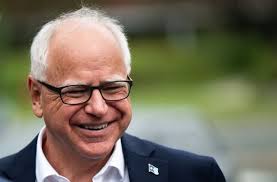
On Aug. 8, Kamala Harris officially chose Tim Walz as her running mate for her presidential campaign, marking a notable decision in the Democratic nomination.
Walz currently serves as the Governor of Minnesota — a Democratic-leaning state with 10 electoral votes. Minnesota has the longest Democratic voting streak in the country besides Washington, D.C., and the last time the state voted Republican was in 1972 with Richard Nixon. The state went to Hillary Clinton in 2016 by a slim 1.5% and Biden in 2020 by 7%.
Walz was born in West Point, Nebraska. He served in the Army National Guard and worked his way up to Command Sergeant Major. Afterward, he attended Chadron State College to receive a B.S. in social science education. After spending a year teaching abroad in China, Walz became a high school teacher and football coach. In 2006, Walz was elected to the House of Representatives, and in 2018 he was elected Governor of Minnesota.
Harris summed up his unconventional past at a rally on Aug. 6 in Philadelphia.
“To those who know him best …Tim is more than a governor. To his wife, Gwen, he is a husband. To his kids, Hope and Gus, he is a dad. To his fellow veterans, he is Sergeant Major Walz. To the people — to the people of Southern Minnesota, for 12 years, he was Congressman. To his former high school students, he was Mr. Walz. And to his former high school football players, he was Coach,” Harris said.
While in the House of Representatives, he focused on issues such as veterans’ affairs and worked on initiatives to support veterans’ mental health.
However, Walz has been met with controversy from the right following his appointment. In 2020, George Floyd was killed in Minneapolis, and following Floyd’s death, Black Lives Matter protests flooded the city. Walz had a delayed reaction in deploying the National Guard — extensive crime and damage occurred in the city under his watch.
Governor Josh Shapiro of Pennsylvania was another top pick for the VP spot. However, as the Israel-Hamas conflict continues to heat up, a pro-Israel VP could potentially alienate pro-Palestine voters.
“I think in the final stretch of this campaign to be the vice presidential pick, we started seeing a lot of acrimony in pockets of the Democratic face, drawing attention to the fact that Governor Shapiro could be divisive on Gaza, which has really sort of split the party in recent months,” Ernesto Langano said. “They made a calculation that Tim Waltz would be more of a unifying figure and would be somebody who would sort of inspire and energize enough pockets of the electorate that they need, particularly in the Midwest, to make him the stronger and more exciting pick and somebody who wouldn’t force them to go back to defending and re-litigating the Biden administration’s record on Israel and on the war in Gaza.”
Pennsylvania is a vital swing state for the Harris campaign to win, and by not choosing Shapiro, Harris weakened her position on winning the state. The decision to choose Walz over Shapiro was a well-calculated and thought-out plan by the campaign, some factors must have outweighed others in choosing Walz.
By picking Walz, Harris perfectly demonstrates the practice of balancing the ticket — a political action seen throughout history. The practice has been replicated countless times, and it allows for a wider range of voters to be won over by a more diverse ticket.
Merriam-Webster defines a balanced ticket as, “a political party ticket with a list of candidates designed to appeal to the major racial, national and religious groups of the electorate.”
In short, this is when a presidential candidate selects a vice president who appeals to a different group of people.
Harris, a Jamaican-Indian born in California, needed to select someone with a different background from her. Walz is an older, white male from the Midwest. On paper, the two are opposites. However, they both are Democrats and are working together on a campaign. In the eyes of the Harris-Walz campaign, the ticket can reach a wider audience of Americans.
Trump also balanced the ticket with his pick of JD Vance. Although the example illustrates a less dramatic contrast, Vance represents a younger audience and a different background of the working class. He’s also from the Midwest — as an Ohio Senator — just like Walz.
The two VPs come from the same regional area in America and are both veterans, but they are already clashing. On Aug. 7, Vance accused Walz of falsely claiming he served in a combat zone during his time serving in the Army National Guard.
“When the United State Marine Corps, when the United States of America asked me to go to Iraq to serve my country, I did it. I did what they asked me to do, and I did it honorably and I’m very proud of that service. When Tim Walz was asked by his country to go to Iraq, you know what he did? He dropped out of the Army and allowed his unit to go without him,” Vance said.
Despite the continuous clashes between the two, a vice presidential debate has not been officially settled — the location and date remain unknown. Before the election, the two will likely meet face-to-face for a heated yet interesting discourse.








